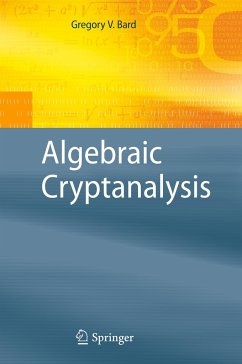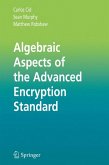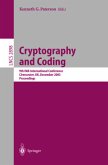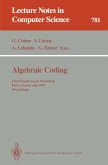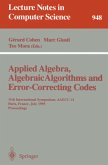Algebraic Cryptanalysis bridges the gap between a course in cryptography, and being able to read the cryptanalytic literature. This book is divided into three parts: Part One covers the process of turning a cipher into a system of equations; Part Two covers finite field linear algebra; Part Three covers the solution of Polynomial Systems of Equations, with a survey of the methods used in practice, including SAT-solvers and the methods of Nicolas Courtois.
Topics include:
Analytic Combinatorics, and its application to cryptanalysis
The equicomplexity of linear algebra operations
Graph coloring
Factoring integers via the quadratic sieve, with its applications to the cryptanalysis of RSA
Algebraic Cryptanalysis is designed for advanced-level students in computer science and mathematics as a secondary text or reference book for self-guided study. This book is suitable for researchers in Applied Abstract Algebra or Algebraic Geometry who wish to find more applied topics or practitioners working for security and communications companies.
Topics include:
Analytic Combinatorics, and its application to cryptanalysis
The equicomplexity of linear algebra operations
Graph coloring
Factoring integers via the quadratic sieve, with its applications to the cryptanalysis of RSA
Algebraic Cryptanalysis is designed for advanced-level students in computer science and mathematics as a secondary text or reference book for self-guided study. This book is suitable for researchers in Applied Abstract Algebra or Algebraic Geometry who wish to find more applied topics or practitioners working for security and communications companies.
From the reviews:
"Algebraic cryptanalysis is a well-titled book. The theme is the reduction of attacks on ciphers (cryptosystems) to systems of polynomial equations over finite fields and subsequent heuristics for efficiently solving these systems. The book is written from the standpoint of real-world computational algebra, and contains numerous gems concerning details on how various algorithms and the heuristics using them really work. The book has an overall tripartite structure." (Bruce Litow, ACM Computing Reviews, April, 2010)
"The book contains of 3 parts, each having 5 chapters, and 5 Appendices which describe code-breaking by solving equation systems. The author explains the mathematical background of the breaking method and exemplifies it on various ciphers. ... The entire work is well structured having a good mathematical background. ... recommended to graduate students who want to do their dissertation in any part of cryptanalysis. It is also useful to researchers in Applied Abstract Algebra, cryptography or any other area of these domains." (Nicolae Constantinescu, Zentralblatt MATH, Vol. 1183, 2010)
"This book gives an overview of algebraic cryptanalysis. ... the book seems to be the only broad treatise on the subject available. ... it can show a graduate student where to look further ... ." (Safuat Hamdy, Mathematical Reviews, Issue 2012 k)
"Algebraic cryptanalysis is a well-titled book. The theme is the reduction of attacks on ciphers (cryptosystems) to systems of polynomial equations over finite fields and subsequent heuristics for efficiently solving these systems. The book is written from the standpoint of real-world computational algebra, and contains numerous gems concerning details on how various algorithms and the heuristics using them really work. The book has an overall tripartite structure." (Bruce Litow, ACM Computing Reviews, April, 2010)
"The book contains of 3 parts, each having 5 chapters, and 5 Appendices which describe code-breaking by solving equation systems. The author explains the mathematical background of the breaking method and exemplifies it on various ciphers. ... The entire work is well structured having a good mathematical background. ... recommended to graduate students who want to do their dissertation in any part of cryptanalysis. It is also useful to researchers in Applied Abstract Algebra, cryptography or any other area of these domains." (Nicolae Constantinescu, Zentralblatt MATH, Vol. 1183, 2010)
"This book gives an overview of algebraic cryptanalysis. ... the book seems to be the only broad treatise on the subject available. ... it can show a graduate student where to look further ... ." (Safuat Hamdy, Mathematical Reviews, Issue 2012 k)

